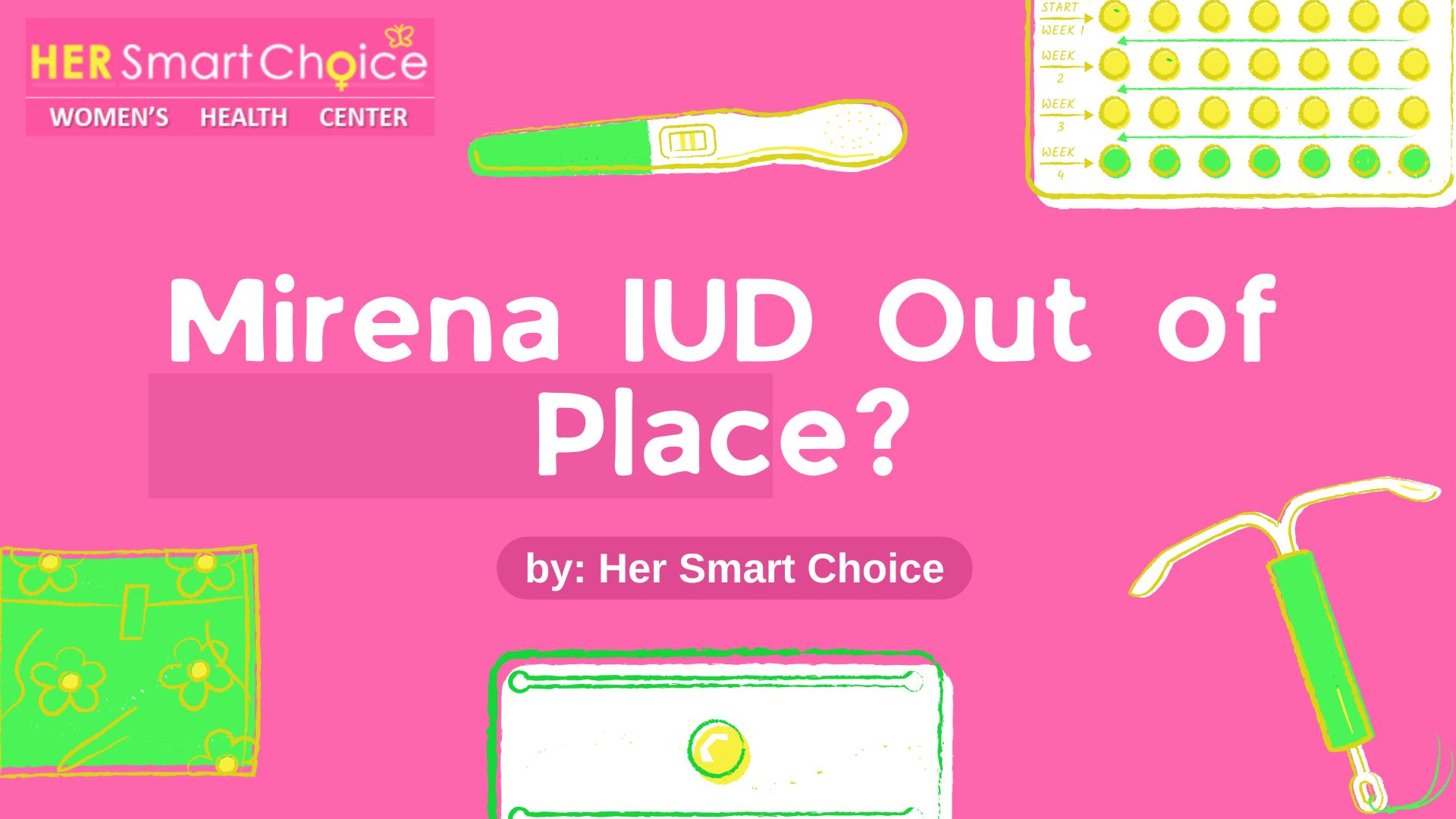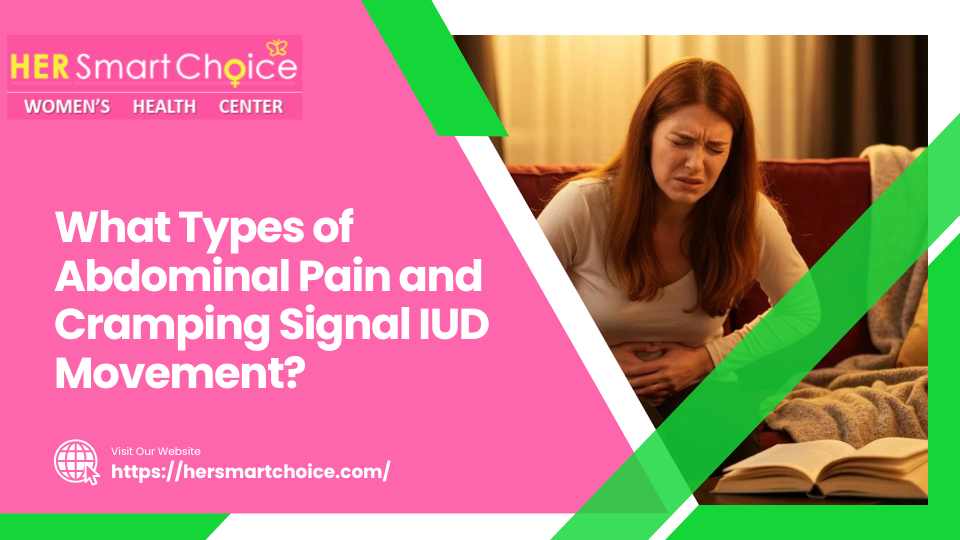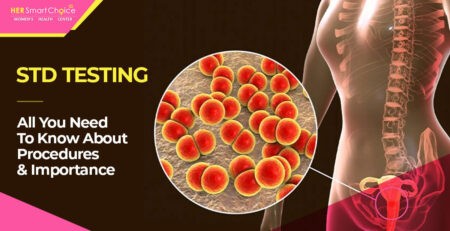Mirena IUD Out of Place? Signs, Risks, and What to Do Next

When a Mirena IUD moves from its proper position, it may reduce birth control effectiveness and cause pain, unusual bleeding, or even pregnancy. In this guide, Her Smart Choice Women’s Abortion Clinic in Los Angeles explains the warning signs of a displaced Mirena IUD, why it happens, how doctors diagnose it, and what steps you should take for safe, reliable contraception.
Follow Us!
Here’s what we’ll cover:
- Common signals of a Mirena IUD that has moved
- Reasons behind displacement and factors that increase risk
- How doctors diagnose movement, from your own checks to imaging
- Possible issues and when to seek urgent help
- Immediate actions and long-term prevention strategies
- The difference between expulsion and displacement
Together, these sections offer a complete picture to help you protect your reproductive health and ensure your Mirena IUD continues to be a reliable form of birth control.
What Are the Common Signs of a Mirena IUD That Has Moved?
If your Mirena IUD moves from its correct position, you’ll likely notice some physical changes. Recognizing these early signs can help you get medical attention before more serious problems arise.
How Do Changes in IUD Strings Indicate Displacement?
One of the first ways to check is by feeling the IUD strings through your cervix. They should be a specific length and texture.
- Gently place a clean finger inside your vagina until you reach your cervix.
- Notice if the strings feel shorter than usual (like they’ve been pulled up) or longer (sticking out more).
- Compare this to how they normally feel: if they suddenly feel different in length or direction, it could mean the IUD has shifted.
Changes in how the strings feel often appear before more noticeable symptoms, prompting a timely check-up.
What Types of Abdominal Pain and Cramping Signal IUD Movement?

Sharp, sudden cramps or ongoing pelvic discomfort can be signs of an IUD that has moved.
- Sudden, sharp pain that comes and goes might suggest the IUD is tilted or starting to embed in the uterine wall.
- A constant, dull ache that lasts for days could indicate it’s gradually moving through the uterine wall.
- Severe cramping during your period might be due to increased uterine contractions pushing the device.
If the pain gets worse when you move or doesn’t go away with your usual cycle, it’s worth getting checked out.
How Does Abnormal Vaginal Bleeding Manifest with a Displaced Mirena IUD?
When a Mirena IUD isn’t in its ideal spot, it can disrupt the uterine lining, leading to:
- Heavier periods than you normally experience
- Spotting between periods that is unusual for you
- Bleeding that lasts longer than seven days
Keeping track of any sudden changes in how heavy or long your bleeding is can help you catch displacement before issues like infection or anemia develop.
What Are the Signs of Unusual Vaginal Discharge Related to IUD Migration?
A displaced IUD can irritate the uterine tissue and potentially introduce bacteria, causing:
- Discharge with a strong, unpleasant odor
- Discharge that is thick or has a yellow-green color, unlike your normal cervical mucus
- More frequent discharge than you typically have outside of ovulation
Noticing a sudden change in the quality or amount of discharge could signal both IUD movement and the start of an infection.
Can You Feel the Mirena IUD or Experience Pain During Sex if It Has Moved?
Yes, a displaced Mirena IUD can cause pain during sex and you might feel the plastic parts of the device:
- Your partner might feel a hard plastic edge during intercourse.
- You might experience sharp pelvic pain when your uterus moves during sex.
- You could feel a deep vaginal discomfort that you never noticed before.
If you can feel the device itself, not just the strings, it suggests it might be partially out or in the wrong place, and you should get it checked.
At Her Smart Choice Women’s Abortion Clinic in Los Angeles, we advise patients to monitor changes in strings, pain, or bleeding closely. Recognizing these early signs helps you seek timely medical care and avoid complications.
What Causes Mirena IUD Displacement and What Are the Risk Factors?
IUDs can move due to physical factors or issues during insertion. Knowing these risks can help you lower the chances of it happening.
How Does Uterine Anatomy Affect the Risk of IUD Movement?
The shape and size of your uterus can influence how well the IUD stays in place:
- A tilted or retroverted uterus can put uneven pressure on one side of the IUD.
- Fibroids or uterine polyps can change the shape of the uterine cavity and push against the device.
- A small or unusually shaped uterine cavity might not provide enough space for the IUD to sit securely.
If your uterus has unique features, your provider might use special techniques during insertion to help keep the IUD stable and reduce the risk of it moving.
Why Is Insertion Timing Important for IUD Stability?
The time right after giving birth or while breastfeeding can affect how well the uterus holds the IUD:
- Inserting an IUD soon after childbirth means the uterus is still enlarged and more prone to expelling the device early on.
- Breastfeeding can lower estrogen levels, making the uterine wall softer and less able to grip the IUD firmly.
- Waiting more than six weeks after birth to insert the IUD allows the uterus to return to its normal size and tone, improving device retention.
Choosing the right time for insertion balances convenience with a lower chance of the IUD moving.
A large study involving over 327,000 women showed that the risk of uterine perforation with an IUD was nearly seven times higher when inserted between four days and six weeks postpartum, and about one-third higher when inserted during breastfeeding. While these risks are increased, perforation is still uncommon, and the benefits of effective contraception usually outweigh these risks.
Can Physical Activity or Uterine Contractions Cause IUD Displacement?
Normal uterine contractions during your period or intense exercise can potentially shift an IUD that isn’t fully settled:
- Strenuous workouts that involve a lot of jarring in the pelvic area could dislodge the IUD.
- Strong uterine spasms during heavy periods can repeatedly move the IUD against the uterine wall.
- Vigorous sexual activity shortly after insertion can destabilize an IUD that hasn’t yet anchored properly.
Taking it easier with high-impact activities and allowing your body time to heal after insertion can help reduce the risk of movement.
How Does Improper Insertion Lead to Mirena IUD Migration?
Mistakes during the insertion process can significantly contribute to the IUD moving:
- Placing the IUD too high in the upper part of the uterus reduces its contact with the uterine tissue, which is needed for it to stay in place.
- Inserting the IUD at the wrong angle can cause one of its arms to puncture the uterine wall or tilt downwards.
- Not fully releasing the IUD’s arms can result in them not opening into the proper T-shape, making the device less stable.
Providers who are experienced and use ultrasound guidance during insertion can minimize these procedural errors and improve the chances of the IUD staying put.
Understanding the factors that contribute to displacement, from your body’s anatomy to the insertion technique, helps set the stage for accurate diagnosis.
How Is a Displaced Mirena IUD Diagnosed?
Confirming if your IUD has moved involves a combination of your own checks, a physical exam by your doctor, and imaging tests to pinpoint its location and assess any movement.
IUDs being out of place or displaced are significant issues that can lead to side effects like abnormal bleeding and pain, and can also reduce how effective the birth control is. This expert opinion stresses the importance of correcting displaced IUDs and points to ultrasound and hysteroscopy as key diagnostic tools.
How Can You Perform a Self-Check for IUD String Changes at Home?
Checking your IUD strings at home can be an early warning sign:
- Wash your hands thoroughly and get into a comfortable position.
- Insert a clean finger into your vagina until you feel the opening of your cervix.
- Gently feel for two thin, flexible strings and note how long they feel and which direction they seem to be pointing.
- Make a note if you feel anything that feels like hard plastic instead of just soft strings.
Doing these checks regularly, perhaps once a month, can help you catch any changes early and prompt you to contact your doctor.
Moving beyond self-checks, a pelvic exam can provide clinical confirmation of the IUD’s position.
What Does a Pelvic Exam Reveal About IUD Position?
During a speculum exam and a bimanual exam, your healthcare provider can:
- See the length of the strings and check for any fraying or if they are missing.
- Feel your cervix to check for tenderness or if the device feels like it’s in an unusual spot.
- Look for signs of infection or perforation, such as fever or unusual discharge.
What your provider feels during the exam can help decide if imaging tests are needed to precisely locate the IUD.
How Are Ultrasound and X-ray Used to Confirm IUD Displacement?
Imaging tests provide definitive proof of the device’s location and whether it might have punctured the uterus. The table below compares common methods.
| Procedure | Typical Detection Rate | Primary Indication |
|---|---|---|
| Transvaginal Ultrasound | 95 percent | Visualizing IUD arms within the uterine cavity |
| Abdominal Ultrasound | 70 percent | Initial screening when transvaginal access is difficult |
| Pelvic X-ray | 100 percent | Confirming expulsion or perforation outside the uterus |
Each method helps determine if the IUD is partially moved, has come out completely, or is embedded in tissue, guiding the next steps in your care.
IUD migration is a rare complication, happening in about one out of every 1,000 cases. It can cause various abdominal symptoms or sometimes have no symptoms at all. Imaging tests like ultrasonography, X-rays, CT scans, and MRI are essential for pinpointing the exact location of a migrated IUD, although sometimes a diagnostic laparoscopy might be needed to find and remove it.
What Are the Risks and Complications of a Mirena IUD That Has Moved?

If your Mirena IUD has moved from its correct position, your chances of experiencing unintended outcomes and serious health issues increase.
Can a Displaced IUD Increase the Risk of Unintended or Ectopic Pregnancy?
Yes. When the IUD is not in the right place, its ability to prevent pregnancy is weakened:
- Less levonorgestrel is released in the upper part of the uterus, reducing the local hormone concentration.
- The fallopian tubes are more open, allowing fertilization to happen more easily.
- The risk of an ectopic pregnancy (where the pregnancy implants outside the uterus) increases if the device blocks the uterus but not the tubes.
Keeping the IUD in its proper position is crucial to maintain Mirena’s effectiveness rate of 99 percent.
What Are the Signs and Dangers of Uterine Perforation?
Perforation happens when the device pushes through the uterine wall. Symptoms can include:
- Severe, localized pain that occurs right after insertion or develops later.
- Bleeding that doesn’t match your normal menstrual cycle.
- Signs of internal injury like fever, low blood pressure, or pain in the shoulder (due to irritation of the diaphragm).
If perforation occurs, you’ll need urgent imaging and possibly surgery to remove the device and prevent further organ damage.
How Does IUD Displacement Lead to Infection or Pelvic Inflammatory Disease?
A moved IUD can allow bacteria to enter the uterus, potentially leading to:
- Pelvic inflammatory disease (PID), which can cause fever, pelvic tenderness, and unusual discharge.
- Endometritis, an inflammation of the uterine lining that causes cramping.
- Abscess formation in severe cases if left untreated.
Removing a displaced IUD promptly and getting antibiotic treatment can help prevent long-term damage to your fertility.
What Are the Long-Term Health Consequences of Undetected IUD Movement?
Leaving a displaced IUD in place for months or years can lead to:
- Chronic pelvic pain from ongoing irritation of the tissues.
- Adhesions, or scar tissue, forming between the uterus and other organs like the bowels.
- Increased risk of infertility due to scarring and structural damage.
Regular check-ups and prompt removal of a migrated IUD are important for protecting your reproductive health.
Understanding these risks highlights why it’s so important to act quickly if you suspect your IUD has moved.
What Should You Do If You Suspect Your Mirena IUD Has Moved?
Taking the right steps immediately can help prevent complications and ensure your birth control continues to work.
What Immediate Steps Should You Take When Noticing Displacement Symptoms?
- Avoid all unprotected sex to prevent an unplanned pregnancy.
- Carefully check your IUD strings in a clean environment.
- Keep track of your symptoms—how bad is the pain, what is your bleeding pattern like, and what are the characteristics of any discharge.
- Contact your healthcare provider to schedule an urgent appointment for an evaluation.
Acting fast will help guide your concerns into a focused diagnostic process.
When Is It Necessary to Seek Emergency Medical Attention?
Seek immediate medical care if you experience any of the following:
- Sudden, severe pelvic or abdominal pain that doesn’t get better with over-the-counter pain relievers
- Heavy bleeding that soaks through a pad in an hour or involves passing large clots
- Signs of shock such as feeling dizzy, fainting, or having a rapid heartbeat
- A high fever (above 101 °F) accompanied by pelvic tenderness
These warning signs could indicate possible perforation, significant bleeding, or a severe infection.
How Do Healthcare Providers Manage a Displaced Mirena IUD?
The treatment approach depends on how much the IUD has moved:
- If partial displacement is confirmed, the IUD is often removed during an office visit.
- If the IUD has come out completely, you’ll need counseling on getting a new one or choosing another form of contraception.
- In cases of perforation, surgery, possibly laparoscopic, might be needed to retrieve the device.
After removal, your provider can discuss when it might be appropriate to have a new IUD inserted or explore other birth control options.
Can Emergency Contraception Be Used After IUD Displacement?
Yes. If you had unprotected sex after your IUD moved:
- Emergency contraceptive pills containing levonorgestrel are effective if taken within 72 hours.
- Ulipristal acetate pills can provide protection for up to 120 hours.
- Inserting a copper IUD within five days can serve as both emergency contraception and long-term birth control.
Talk to your doctor promptly about emergency options to maintain pregnancy prevention.
Knowing these steps ensures you and your provider can work together effectively to resolve any IUD displacement issues.
How Can You Prevent Mirena IUD Displacement and Ensure Proper Follow-Up?
Keeping your IUD stable involves proactive checks and working closely with your healthcare provider.
How Often Should You Check Your IUD Strings to Detect Movement Early?
It’s recommended to check your IUD strings monthly:
- Perform these checks after each menstrual period.
- Record the length of the strings in a log or app so you can compare them over time.
- Contact your doctor if the strings feel noticeably shorter, longer, or if you can’t feel them at all.
Regular self-monitoring helps you feel confident about your IUD’s position and alerts you to any early signs of shifting.
Why Are Follow-Up Appointments Important After IUD Insertion?
Scheduled appointments help confirm the IUD is in the right place and address any concerns:
- Your first follow-up, usually around 4–6 weeks after insertion, confirms correct placement through an exam or ultrasound.
- Annual check-ins allow for ongoing monitoring for any changes in your anatomy or new symptoms.
- You should schedule visits anytime you experience unusual pain or bleeding.
Consistent professional oversight, combined with your monthly self-checks, offers the best protection.
What Lifestyle or Health Factors Can Help Reduce Displacement Risk?
Adjusting your daily habits can help support your uterus and keep the IUD in place:
- Avoid high-impact exercise for the first two weeks after insertion.
- Maintain a healthy weight to help stabilize your hormone levels.
- Manage conditions like fibroids or polyps with medical guidance to preserve the shape of your uterine cavity.
Incorporating these practices can help create an environment within your body that naturally holds the IUD securely.
A thorough prevention plan combines self-checks, follow-up care, and lifestyle adjustments.
How Does Mirena IUD Expulsion Differ from Displacement?
While displacement means the IUD has moved partially, expulsion means it has come out completely. Understanding the difference helps guide the right course of action.
What Are the Key Differences Between IUD Expulsion and Partial Displacement?
| Feature | Displacement | Expulsion |
|---|---|---|
| Device Position | Still inside the uterus, but not correctly aligned | Completely outside the uterus |
| Symptoms | Varying pain, changes in string length | Sudden heavy bleeding, inability to feel strings |
| Contraceptive Protection | Reduced, but not entirely lost | Completely lost |
How Can You Identify Signs Specific to Mirena IUD Expulsion?
Key signs that your Mirena IUD may have come out completely include:
- The strings are completely missing when you do a self-check.
- Sudden, heavy bleeding similar to a very heavy period.
- Feeling the device itself when it comes out into your underwear or vagina.
If you find the device or confirm it has been expelled, you need to arrange for new contraception immediately.
What Are the Next Steps After Confirming Expulsion Versus Displacement?
If your IUD has been expelled:
- Use backup birth control, like condoms, right away.
- Discuss getting a new Mirena IUD or another type of IUD inserted.
- Consider a copper IUD, which can serve as both emergency contraception and long-term birth control.
If your IUD has been displaced:
- Schedule an appointment for removal or repositioning by your provider as soon as possible.
- Follow any instructions for pain management and infection prevention.
- Only consider reinsertion after your uterus has fully healed and your provider gives the okay.
Clearly distinguishing between expulsion and displacement ensures you follow the correct steps to regain reliable birth control.
Recognizing and responding to a Mirena IUD that has moved is essential for maintaining both your birth control’s effectiveness and your reproductive health. By monitoring changes in your strings, pain, bleeding, and discharge; understanding the risk factors; seeking prompt diagnosis; and following professional advice for removal or replacement, you can prevent complications and have peace of mind. Regular self-checks, scheduled follow-up appointments, and informed lifestyle choices create a strong strategy against displacement and expulsion, ensuring your IUD remains an effective, long-term contraceptive solution.
FAQ
You may notice changes in string length, new cramping, unusual bleeding, or pain during sex. If symptoms persist, consult your doctor promptly.
Yes, if the IUD is not in the correct position, its effectiveness drops and the risk of pregnancy—including ectopic pregnancy—increases.
Avoid unprotected sex, check your strings, note symptoms, and contact a healthcare provider right away for evaluation.
Strenuous workouts, heavy periods, or vigorous sex soon after insertion may increase the risk of movement. Once settled, normal activity is usually safe.
Her Smart Choice provides diagnosis, removal, and replacement of IUDs. Our team ensures safe, confidential reproductive health care.
About Her Smart Choice
Her Smart Choice is a trusted women’s Abortion clinic in Los Angeles, California, specializing in abortion care, birth control, and reproductive health. Our licensed medical team reviews all educational content to ensure accuracy and compassionate guidance.
Disclaimer: This article is for informational purposes only and is not a substitute for medical advice. Always consult a licensed healthcare provider for personalized care. Her Smart Choice abortion Clinic in Los Angeles offers confidential, professional reproductive health services.
Follow Us!










